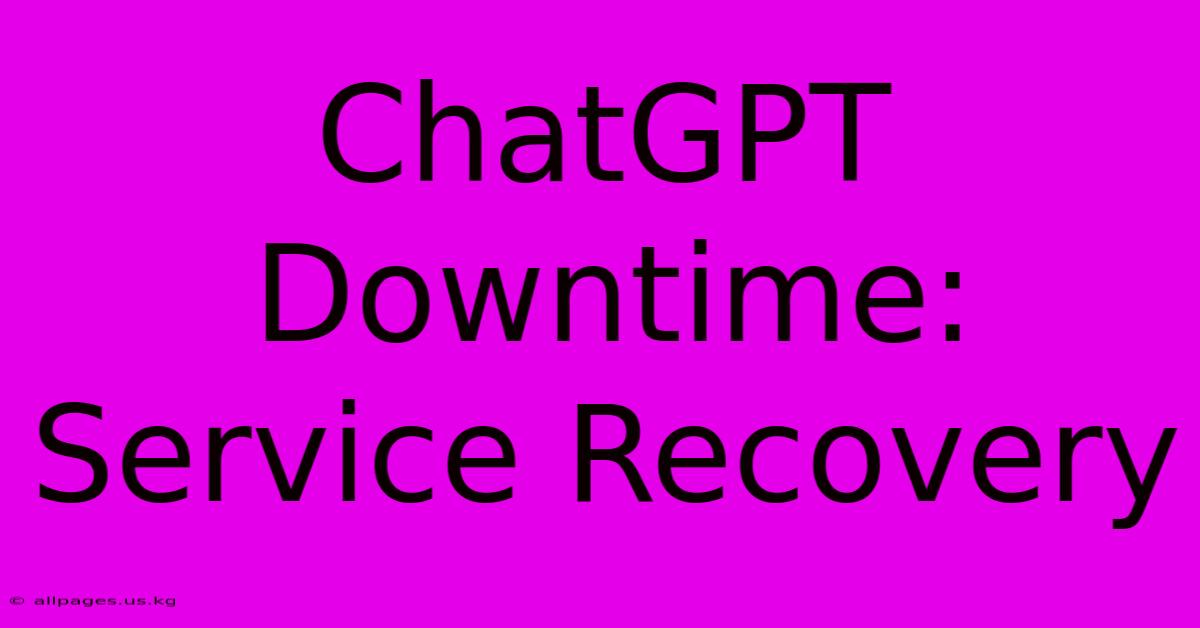ChatGPT Downtime: Service Recovery

Discover more detailed and exciting information on our website. Click the link below to start your adventure: Visit Best Website allpages.us.kg. Don't miss out!
Table of Contents
ChatGPT Downtime: Service Recovery Strategies for Users and OpenAI
ChatGPT, the revolutionary AI chatbot, has become an indispensable tool for many. However, like any online service, it experiences occasional downtime. This article explores strategies for navigating ChatGPT downtime, focusing on both user-side actions and OpenAI's role in service recovery.
Understanding ChatGPT Downtime
Downtime can stem from various sources, including:
- High traffic: A sudden surge in users can overwhelm the servers.
- Maintenance: Scheduled maintenance is necessary for upgrades and improvements.
- Technical issues: Unexpected bugs or server problems can lead to interruptions.
- Cyberattacks: While less frequent, security breaches can disrupt service.
Regardless of the cause, downtime can be frustrating, especially for users relying on ChatGPT for critical tasks.
User Strategies During ChatGPT Downtime
When ChatGPT is unavailable, users can employ several strategies to minimize disruption:
1. Check OpenAI's Status Pages
OpenAI often provides updates on its service status through dedicated status pages or social media channels. Checking these pages is the first step in determining the nature and extent of the downtime. Knowing if it's a widespread issue or a localized problem significantly impacts your next steps.
2. Try Alternative Solutions
Consider alternative tools or methods to accomplish your tasks while ChatGPT is unavailable. If you're using ChatGPT for writing, explore other writing aids. For coding, turn to alternative IDEs or online resources. This proactive approach prevents complete workflow paralysis.
3. Practice Patience and Avoid Repeated Attempts
Continuously trying to access ChatGPT during downtime will not speed up the process and may even exacerbate server load. Patience is crucial. OpenAI's engineers are likely working to restore service as quickly as possible.
4. Engage with the OpenAI Community
Online forums, social media groups, and the OpenAI community itself can be valuable resources. You can find out if others are experiencing the same issue, share your experience, and perhaps even glean insights into potential workarounds or estimated recovery times. This fosters a sense of community and shared understanding during disruptions.
OpenAI's Role in Service Recovery
OpenAI's responsibility extends beyond simply acknowledging downtime. Effective service recovery involves:
1. Transparent Communication
Proactive communication is key. OpenAI should promptly inform users about the downtime, its cause (if possible without compromising security), and an estimated time of restoration. This transparency builds trust and manages user expectations.
2. Swift Resolution
Minimizing downtime is paramount. OpenAI needs robust monitoring systems and a skilled technical team to quickly identify and resolve issues. Investing in infrastructure and employing proactive maintenance strategies reduces the frequency and duration of outages.
3. Post-Incident Analysis
Following a downtime event, a thorough analysis should be conducted. This involves identifying the root cause, implementing corrective measures to prevent recurrence, and improving the overall system's resilience. This continuous improvement cycle is vital for maintaining service reliability.
4. Compensating Users (if applicable)
In cases of prolonged or significant downtime affecting many users, OpenAI might consider offering compensatory measures. This could involve extending subscriptions or providing credits. This demonstrates a commitment to customer satisfaction and acknowledges the inconvenience caused.
Conclusion
ChatGPT downtime is an inevitable reality. However, proactive strategies for users and effective service recovery mechanisms from OpenAI can minimize the impact of these interruptions. By understanding the potential causes, employing alternative solutions, and expecting transparent communication from the service provider, users can navigate downtime more efficiently and maintain productivity. OpenAI's focus on rapid resolution, post-incident analysis, and potentially compensatory measures further strengthens user trust and overall service quality.

Thank you for visiting our website wich cover about ChatGPT Downtime: Service Recovery. We hope the information provided has been useful to you. Feel free to contact us if you have any questions or need further assistance. See you next time and dont miss to bookmark.
Featured Posts
-
Live Chelsea Vs Fulham Final Score
Dec 27, 2024
-
Pittsburgh Falls To Toledo In Six Ots
Dec 27, 2024
-
Geno Smiths 15 Yard Dart To Lockett
Dec 27, 2024
-
City Slip Again Everton Vs Man City Result
Dec 27, 2024
-
Wordle Clue Nyt Puzzle 1287 Dec 27
Dec 27, 2024
